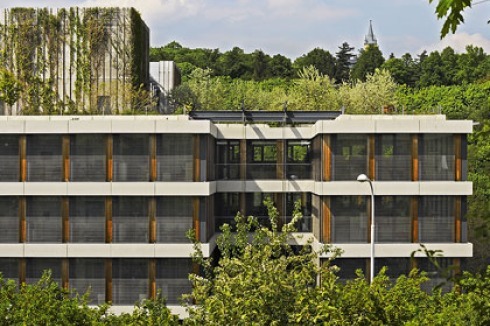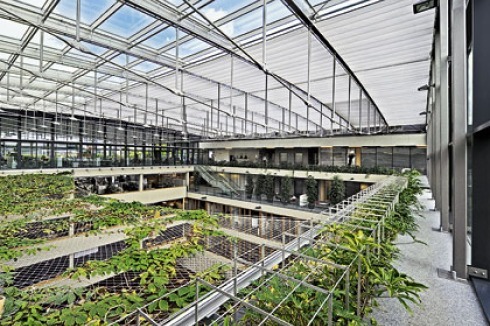ČSOB-Bank
Text: Okamura, Osamu, Brünn
ČSOB-Bank
Text: Okamura, Osamu, Brünn
As flagship of the new Czech architecture Osamu Okamura presents a big office building the roof of which has been designed as a greenhouse. In this project, a partly glassed-in, partly open jungle has been realized, a green plateau visually blending with the distant forested slopes.
This large-scale low-energy consumption office building completed in 2007 establishes a new standard of sustainable building awareness in Czech Republic. It is located in a small valley of Radlice, within a wider Prague center, right beside the metro station. The underground structure of an existing metro tunnel actually limited land-use for many years at this place. Only by employing clever bridge-structure solution as a part of building’s foundations, this “brownfield” might have been developed into a working space for 2 400 bank officers.
The initial conditions, formulated by the investor, allowed for a non-traditional approach to a modern banking institution representation. Instead of pretending financial stability, sense of continuity and winning customers’ confidence by means of traditional architectural solutions and materials, the investor and architect expressed their credo in the form of built statement in the sense, that financial stability is essentially interconnected with global sustainability issues: If we won’t live environmentally responsibly, no money could ever save us.
The natural setting of this location, so rare in the very proximity of the city center, predestined architect’s spatial solution consisting of a single large longitudinal low-rise block, imperceptibly stepping down the slope, block rather simple and calm, filling the valley bottom to certain extent. The general volume is further subdivided by three inner courtyards and two atriums into six sections. Although strictly modular, variety of repeating single details create a very complex environment. Spatially the architect speaks rather in terms of urban design than of architecture, as of inner streets, avenues and squares. These urban aspects are relevant not only in terms of the interior space organization, but are also characterized by search of informality, flexibility, creativity and openness and in total these attempt to provide enjoyable and highly cultivated and productive working environment, completed with distinctive graphic design elements and even on-demand and site-specific works of contemporary art.
Moreover this building serves as a catalyst of structural and social transformation of above mentioned banking institution, that was until recently dispersed in numerous historical objects in Prague’s city centre, and as such, physically represents the new corporate culture.
The valley morphology allows us to perceive the roof from above as a regular fifth façade. Therefore the roof was carefully designed as an extensive green roof or better say roof garden terrace, in a good weather fully accessible by officers as an alternative working and meeting place. Trees and plants camouflage not only air-conditioning technology blocks, but actually provide effective mimicry for the whole building. As the vegetation grows bigger, the building becomes more and more invisible. In a more profound sense, one could say that officers, office space, building structure and surrounding nature tend to merge into one.
This overall modest approach traded superficial effects of commercial culture for more sophisticated technological solutions: open façade with large windows allows maximal daylight to the office open-spaces and provides eye-contact with the surrounding nature, instead of heavy and expensive-looking materials we find here wooden plank cladding. Also you find here intelligent louver shading system, air recuperation and automatic building environment control. Banking business rhetoric of the past seems to be limited to the minimum in favor of ethics of a high-quality working environment. And that seems to be promising pattern for new developments in our region.









0 Kommentare